Service Process Design
VerifiedAdded on 2023/04/11
|8
|1723
|164
AI Summary
This article discusses the process of designing a service delivery model and its importance in creating value for customers and ensuring business stability. It covers factors to consider, such as customer requirements, location, standardization, customer participation, and complexity of the service. The role of information technology in service process design is also explored.
Contribute Materials
Your contribution can guide someone’s learning journey. Share your
documents today.
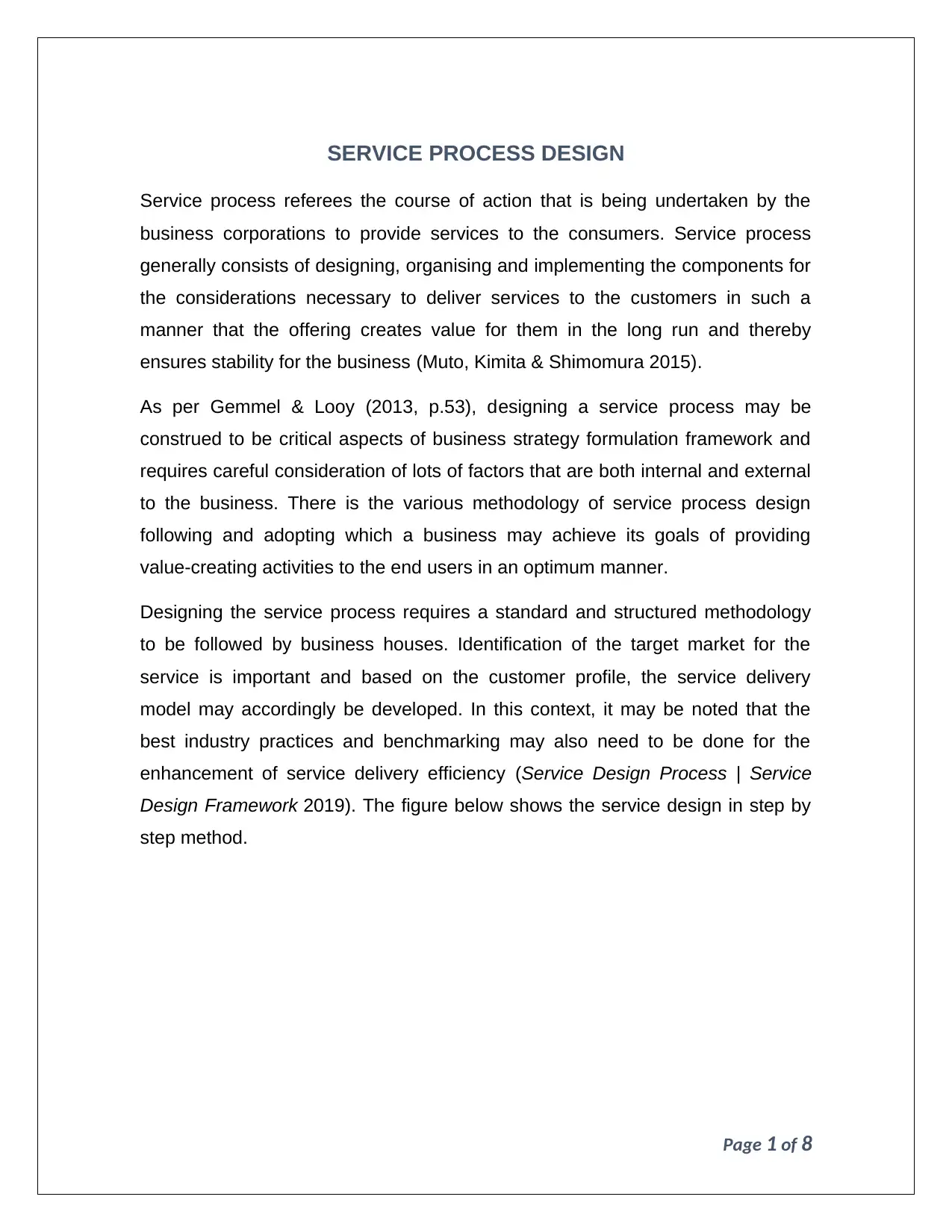
SERVICE PROCESS DESIGN
Service process referees the course of action that is being undertaken by the
business corporations to provide services to the consumers. Service process
generally consists of designing, organising and implementing the components for
the considerations necessary to deliver services to the customers in such a
manner that the offering creates value for them in the long run and thereby
ensures stability for the business (Muto, Kimita & Shimomura 2015).
As per Gemmel & Looy (2013, p.53), designing a service process may be
construed to be critical aspects of business strategy formulation framework and
requires careful consideration of lots of factors that are both internal and external
to the business. There is the various methodology of service process design
following and adopting which a business may achieve its goals of providing
value-creating activities to the end users in an optimum manner.
Designing the service process requires a standard and structured methodology
to be followed by business houses. Identification of the target market for the
service is important and based on the customer profile, the service delivery
model may accordingly be developed. In this context, it may be noted that the
best industry practices and benchmarking may also need to be done for the
enhancement of service delivery efficiency (Service Design Process | Service
Design Framework 2019). The figure below shows the service design in step by
step method.
Page 1 of 8
Service process referees the course of action that is being undertaken by the
business corporations to provide services to the consumers. Service process
generally consists of designing, organising and implementing the components for
the considerations necessary to deliver services to the customers in such a
manner that the offering creates value for them in the long run and thereby
ensures stability for the business (Muto, Kimita & Shimomura 2015).
As per Gemmel & Looy (2013, p.53), designing a service process may be
construed to be critical aspects of business strategy formulation framework and
requires careful consideration of lots of factors that are both internal and external
to the business. There is the various methodology of service process design
following and adopting which a business may achieve its goals of providing
value-creating activities to the end users in an optimum manner.
Designing the service process requires a standard and structured methodology
to be followed by business houses. Identification of the target market for the
service is important and based on the customer profile, the service delivery
model may accordingly be developed. In this context, it may be noted that the
best industry practices and benchmarking may also need to be done for the
enhancement of service delivery efficiency (Service Design Process | Service
Design Framework 2019). The figure below shows the service design in step by
step method.
Page 1 of 8
Secure Best Marks with AI Grader
Need help grading? Try our AI Grader for instant feedback on your assignments.
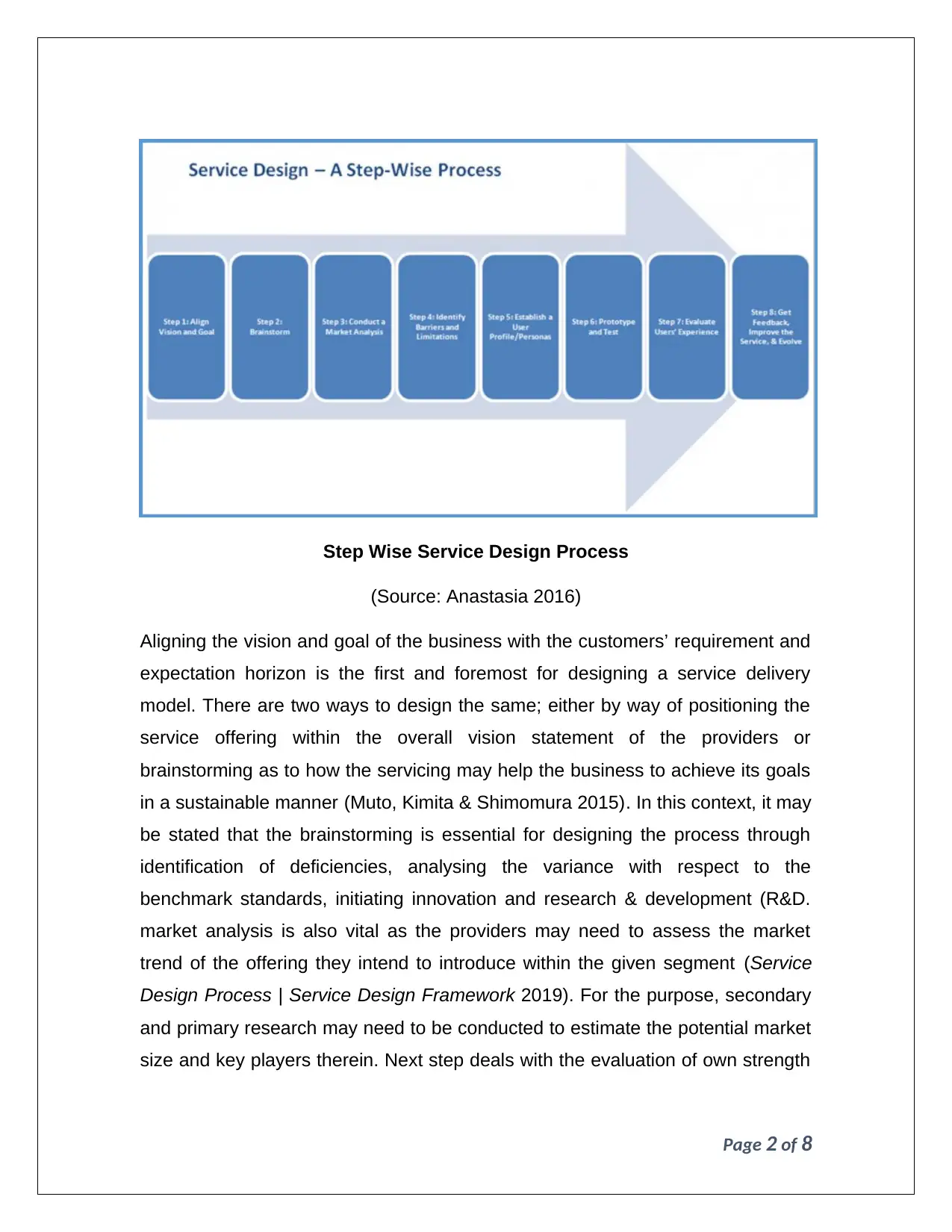
Step Wise Service Design Process
(Source: Anastasia 2016)
Aligning the vision and goal of the business with the customers’ requirement and
expectation horizon is the first and foremost for designing a service delivery
model. There are two ways to design the same; either by way of positioning the
service offering within the overall vision statement of the providers or
brainstorming as to how the servicing may help the business to achieve its goals
in a sustainable manner (Muto, Kimita & Shimomura 2015). In this context, it may
be stated that the brainstorming is essential for designing the process through
identification of deficiencies, analysing the variance with respect to the
benchmark standards, initiating innovation and research & development (R&D.
market analysis is also vital as the providers may need to assess the market
trend of the offering they intend to introduce within the given segment (Service
Design Process | Service Design Framework 2019). For the purpose, secondary
and primary research may need to be conducted to estimate the potential market
size and key players therein. Next step deals with the evaluation of own strength
Page 2 of 8
(Source: Anastasia 2016)
Aligning the vision and goal of the business with the customers’ requirement and
expectation horizon is the first and foremost for designing a service delivery
model. There are two ways to design the same; either by way of positioning the
service offering within the overall vision statement of the providers or
brainstorming as to how the servicing may help the business to achieve its goals
in a sustainable manner (Muto, Kimita & Shimomura 2015). In this context, it may
be stated that the brainstorming is essential for designing the process through
identification of deficiencies, analysing the variance with respect to the
benchmark standards, initiating innovation and research & development (R&D.
market analysis is also vital as the providers may need to assess the market
trend of the offering they intend to introduce within the given segment (Service
Design Process | Service Design Framework 2019). For the purpose, secondary
and primary research may need to be conducted to estimate the potential market
size and key players therein. Next step deals with the evaluation of own strength
Page 2 of 8
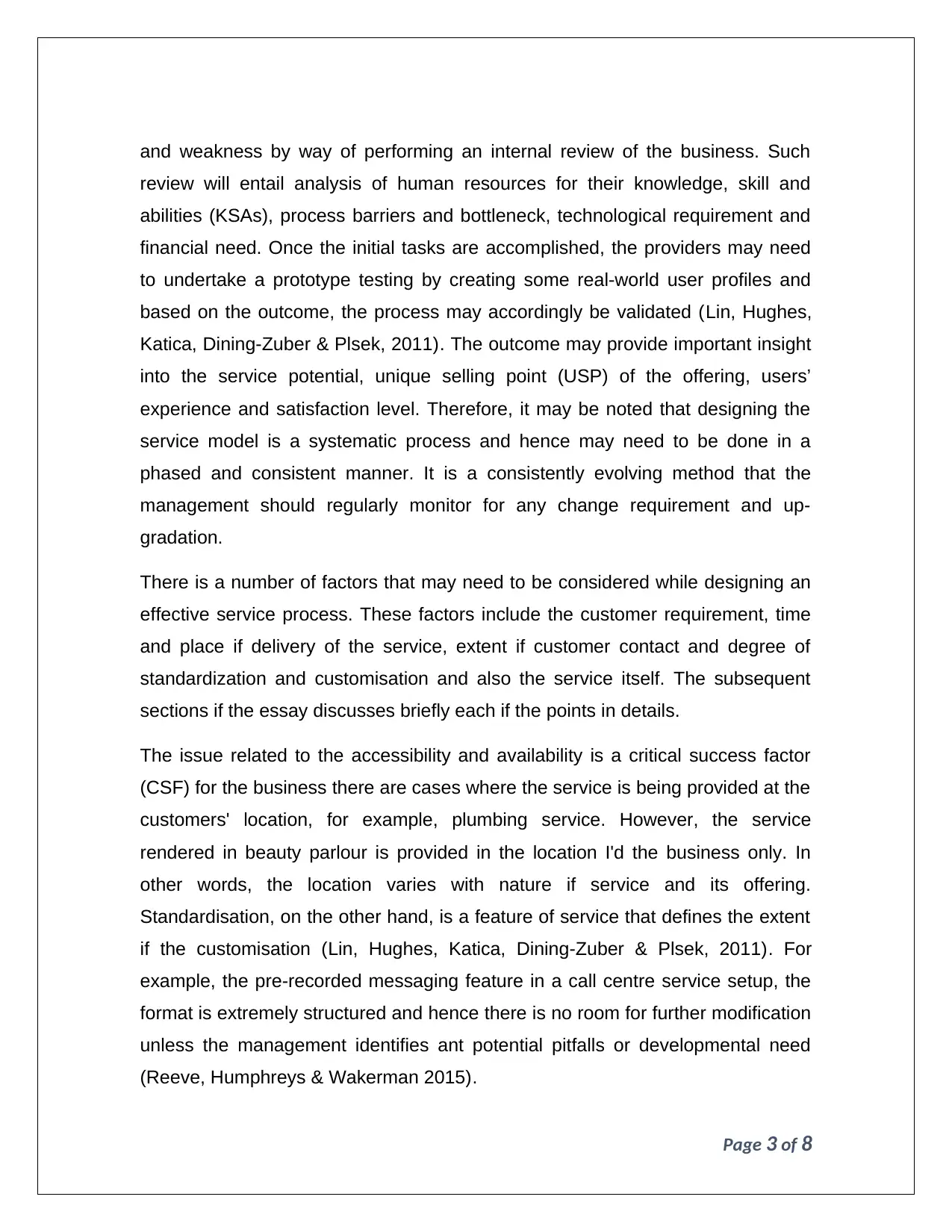
and weakness by way of performing an internal review of the business. Such
review will entail analysis of human resources for their knowledge, skill and
abilities (KSAs), process barriers and bottleneck, technological requirement and
financial need. Once the initial tasks are accomplished, the providers may need
to undertake a prototype testing by creating some real-world user profiles and
based on the outcome, the process may accordingly be validated (Lin, Hughes,
Katica, Dining-Zuber & Plsek, 2011). The outcome may provide important insight
into the service potential, unique selling point (USP) of the offering, users’
experience and satisfaction level. Therefore, it may be noted that designing the
service model is a systematic process and hence may need to be done in a
phased and consistent manner. It is a consistently evolving method that the
management should regularly monitor for any change requirement and up-
gradation.
There is a number of factors that may need to be considered while designing an
effective service process. These factors include the customer requirement, time
and place if delivery of the service, extent if customer contact and degree of
standardization and customisation and also the service itself. The subsequent
sections if the essay discusses briefly each if the points in details.
The issue related to the accessibility and availability is a critical success factor
(CSF) for the business there are cases where the service is being provided at the
customers' location, for example, plumbing service. However, the service
rendered in beauty parlour is provided in the location I'd the business only. In
other words, the location varies with nature if service and its offering.
Standardisation, on the other hand, is a feature of service that defines the extent
if the customisation (Lin, Hughes, Katica, Dining-Zuber & Plsek, 2011). For
example, the pre-recorded messaging feature in a call centre service setup, the
format is extremely structured and hence there is no room for further modification
unless the management identifies ant potential pitfalls or developmental need
(Reeve, Humphreys & Wakerman 2015).
Page 3 of 8
review will entail analysis of human resources for their knowledge, skill and
abilities (KSAs), process barriers and bottleneck, technological requirement and
financial need. Once the initial tasks are accomplished, the providers may need
to undertake a prototype testing by creating some real-world user profiles and
based on the outcome, the process may accordingly be validated (Lin, Hughes,
Katica, Dining-Zuber & Plsek, 2011). The outcome may provide important insight
into the service potential, unique selling point (USP) of the offering, users’
experience and satisfaction level. Therefore, it may be noted that designing the
service model is a systematic process and hence may need to be done in a
phased and consistent manner. It is a consistently evolving method that the
management should regularly monitor for any change requirement and up-
gradation.
There is a number of factors that may need to be considered while designing an
effective service process. These factors include the customer requirement, time
and place if delivery of the service, extent if customer contact and degree of
standardization and customisation and also the service itself. The subsequent
sections if the essay discusses briefly each if the points in details.
The issue related to the accessibility and availability is a critical success factor
(CSF) for the business there are cases where the service is being provided at the
customers' location, for example, plumbing service. However, the service
rendered in beauty parlour is provided in the location I'd the business only. In
other words, the location varies with nature if service and its offering.
Standardisation, on the other hand, is a feature of service that defines the extent
if the customisation (Lin, Hughes, Katica, Dining-Zuber & Plsek, 2011). For
example, the pre-recorded messaging feature in a call centre service setup, the
format is extremely structured and hence there is no room for further modification
unless the management identifies ant potential pitfalls or developmental need
(Reeve, Humphreys & Wakerman 2015).
Page 3 of 8
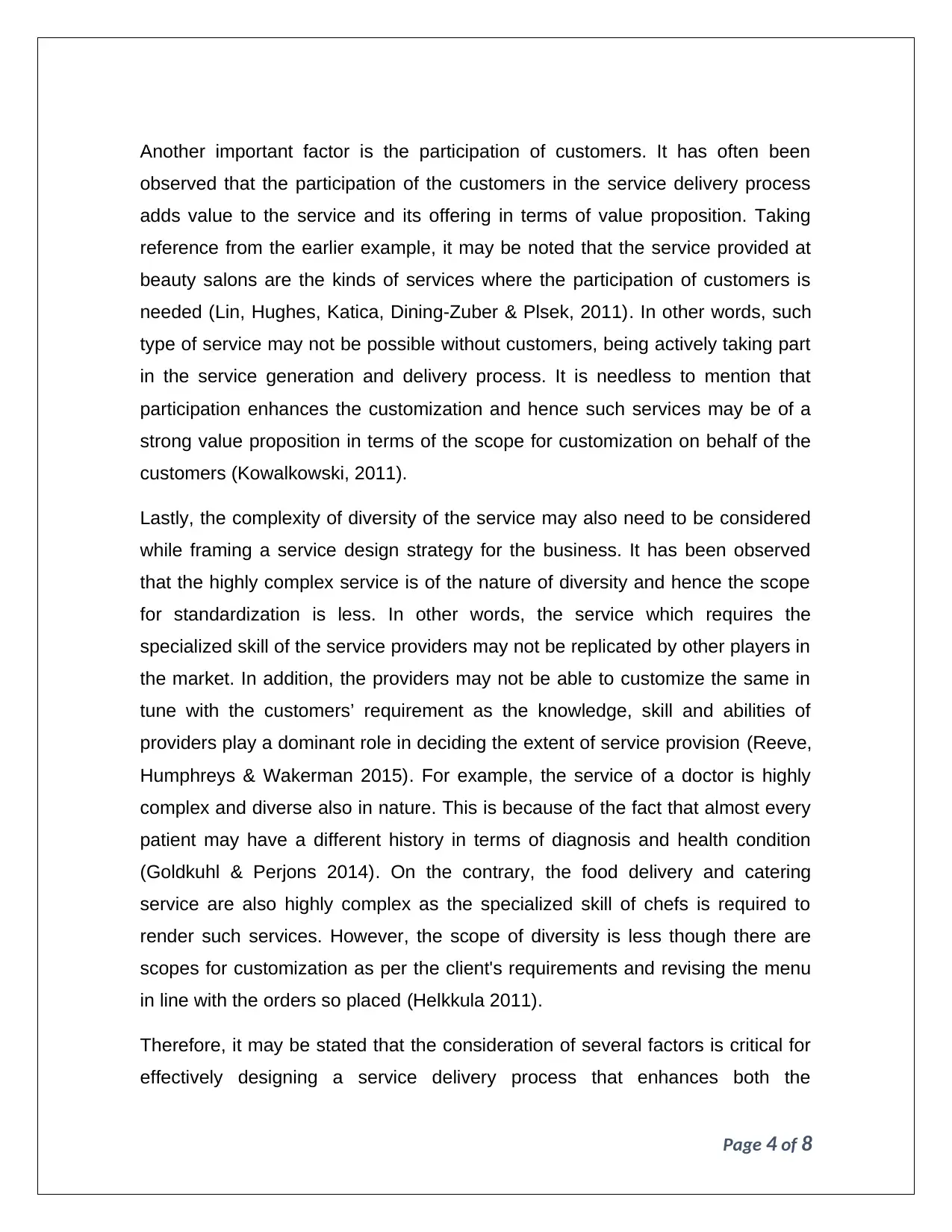
Another important factor is the participation of customers. It has often been
observed that the participation of the customers in the service delivery process
adds value to the service and its offering in terms of value proposition. Taking
reference from the earlier example, it may be noted that the service provided at
beauty salons are the kinds of services where the participation of customers is
needed (Lin, Hughes, Katica, Dining-Zuber & Plsek, 2011). In other words, such
type of service may not be possible without customers, being actively taking part
in the service generation and delivery process. It is needless to mention that
participation enhances the customization and hence such services may be of a
strong value proposition in terms of the scope for customization on behalf of the
customers (Kowalkowski, 2011).
Lastly, the complexity of diversity of the service may also need to be considered
while framing a service design strategy for the business. It has been observed
that the highly complex service is of the nature of diversity and hence the scope
for standardization is less. In other words, the service which requires the
specialized skill of the service providers may not be replicated by other players in
the market. In addition, the providers may not be able to customize the same in
tune with the customers’ requirement as the knowledge, skill and abilities of
providers play a dominant role in deciding the extent of service provision (Reeve,
Humphreys & Wakerman 2015). For example, the service of a doctor is highly
complex and diverse also in nature. This is because of the fact that almost every
patient may have a different history in terms of diagnosis and health condition
(Goldkuhl & Perjons 2014). On the contrary, the food delivery and catering
service are also highly complex as the specialized skill of chefs is required to
render such services. However, the scope of diversity is less though there are
scopes for customization as per the client's requirements and revising the menu
in line with the orders so placed (Helkkula 2011).
Therefore, it may be stated that the consideration of several factors is critical for
effectively designing a service delivery process that enhances both the
Page 4 of 8
observed that the participation of the customers in the service delivery process
adds value to the service and its offering in terms of value proposition. Taking
reference from the earlier example, it may be noted that the service provided at
beauty salons are the kinds of services where the participation of customers is
needed (Lin, Hughes, Katica, Dining-Zuber & Plsek, 2011). In other words, such
type of service may not be possible without customers, being actively taking part
in the service generation and delivery process. It is needless to mention that
participation enhances the customization and hence such services may be of a
strong value proposition in terms of the scope for customization on behalf of the
customers (Kowalkowski, 2011).
Lastly, the complexity of diversity of the service may also need to be considered
while framing a service design strategy for the business. It has been observed
that the highly complex service is of the nature of diversity and hence the scope
for standardization is less. In other words, the service which requires the
specialized skill of the service providers may not be replicated by other players in
the market. In addition, the providers may not be able to customize the same in
tune with the customers’ requirement as the knowledge, skill and abilities of
providers play a dominant role in deciding the extent of service provision (Reeve,
Humphreys & Wakerman 2015). For example, the service of a doctor is highly
complex and diverse also in nature. This is because of the fact that almost every
patient may have a different history in terms of diagnosis and health condition
(Goldkuhl & Perjons 2014). On the contrary, the food delivery and catering
service are also highly complex as the specialized skill of chefs is required to
render such services. However, the scope of diversity is less though there are
scopes for customization as per the client's requirements and revising the menu
in line with the orders so placed (Helkkula 2011).
Therefore, it may be stated that the consideration of several factors is critical for
effectively designing a service delivery process that enhances both the
Page 4 of 8
Secure Best Marks with AI Grader
Need help grading? Try our AI Grader for instant feedback on your assignments.
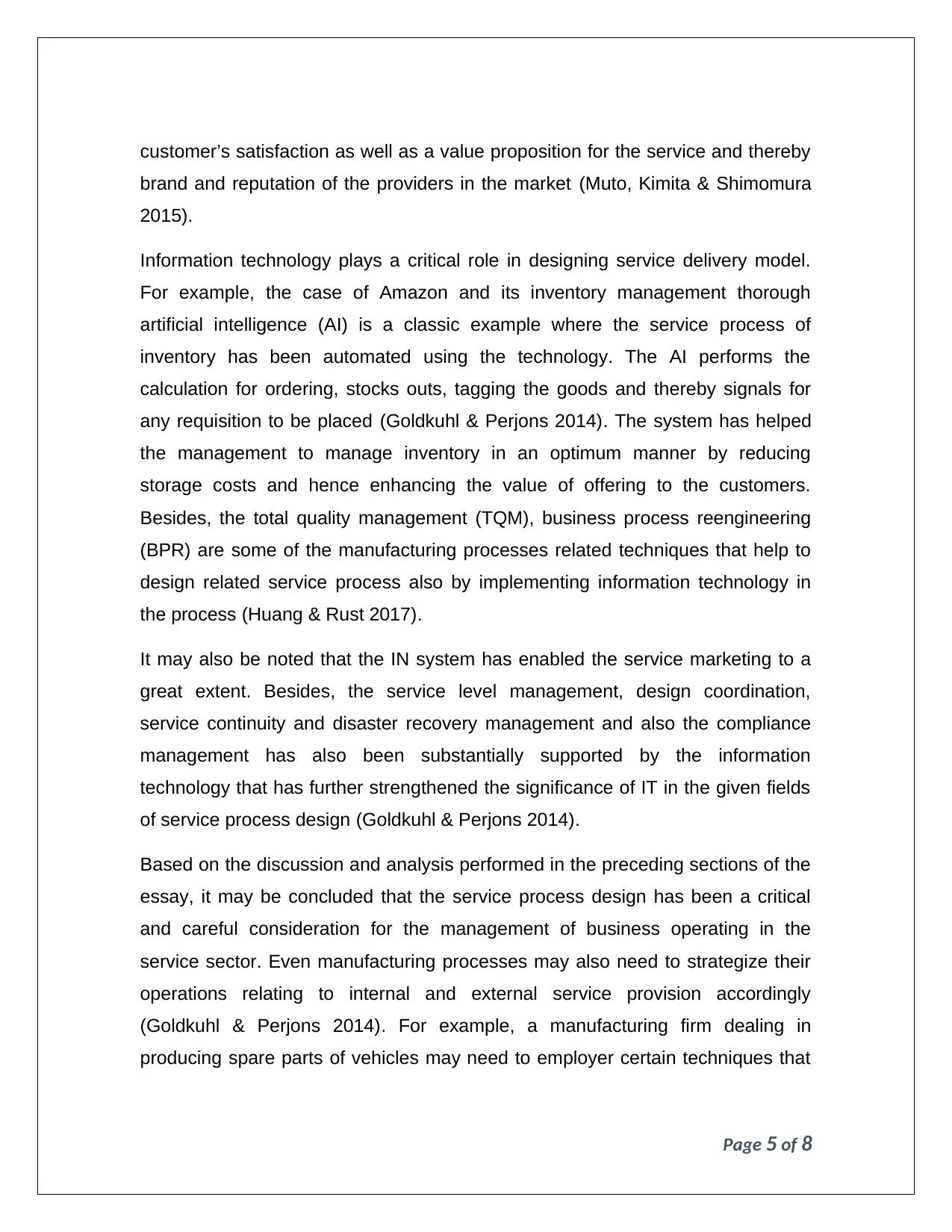
customer’s satisfaction as well as a value proposition for the service and thereby
brand and reputation of the providers in the market (Muto, Kimita & Shimomura
2015).
Information technology plays a critical role in designing service delivery model.
For example, the case of Amazon and its inventory management thorough
artificial intelligence (AI) is a classic example where the service process of
inventory has been automated using the technology. The AI performs the
calculation for ordering, stocks outs, tagging the goods and thereby signals for
any requisition to be placed (Goldkuhl & Perjons 2014). The system has helped
the management to manage inventory in an optimum manner by reducing
storage costs and hence enhancing the value of offering to the customers.
Besides, the total quality management (TQM), business process reengineering
(BPR) are some of the manufacturing processes related techniques that help to
design related service process also by implementing information technology in
the process (Huang & Rust 2017).
It may also be noted that the IN system has enabled the service marketing to a
great extent. Besides, the service level management, design coordination,
service continuity and disaster recovery management and also the compliance
management has also been substantially supported by the information
technology that has further strengthened the significance of IT in the given fields
of service process design (Goldkuhl & Perjons 2014).
Based on the discussion and analysis performed in the preceding sections of the
essay, it may be concluded that the service process design has been a critical
and careful consideration for the management of business operating in the
service sector. Even manufacturing processes may also need to strategize their
operations relating to internal and external service provision accordingly
(Goldkuhl & Perjons 2014). For example, a manufacturing firm dealing in
producing spare parts of vehicles may need to employer certain techniques that
Page 5 of 8
brand and reputation of the providers in the market (Muto, Kimita & Shimomura
2015).
Information technology plays a critical role in designing service delivery model.
For example, the case of Amazon and its inventory management thorough
artificial intelligence (AI) is a classic example where the service process of
inventory has been automated using the technology. The AI performs the
calculation for ordering, stocks outs, tagging the goods and thereby signals for
any requisition to be placed (Goldkuhl & Perjons 2014). The system has helped
the management to manage inventory in an optimum manner by reducing
storage costs and hence enhancing the value of offering to the customers.
Besides, the total quality management (TQM), business process reengineering
(BPR) are some of the manufacturing processes related techniques that help to
design related service process also by implementing information technology in
the process (Huang & Rust 2017).
It may also be noted that the IN system has enabled the service marketing to a
great extent. Besides, the service level management, design coordination,
service continuity and disaster recovery management and also the compliance
management has also been substantially supported by the information
technology that has further strengthened the significance of IT in the given fields
of service process design (Goldkuhl & Perjons 2014).
Based on the discussion and analysis performed in the preceding sections of the
essay, it may be concluded that the service process design has been a critical
and careful consideration for the management of business operating in the
service sector. Even manufacturing processes may also need to strategize their
operations relating to internal and external service provision accordingly
(Goldkuhl & Perjons 2014). For example, a manufacturing firm dealing in
producing spare parts of vehicles may need to employer certain techniques that
Page 5 of 8
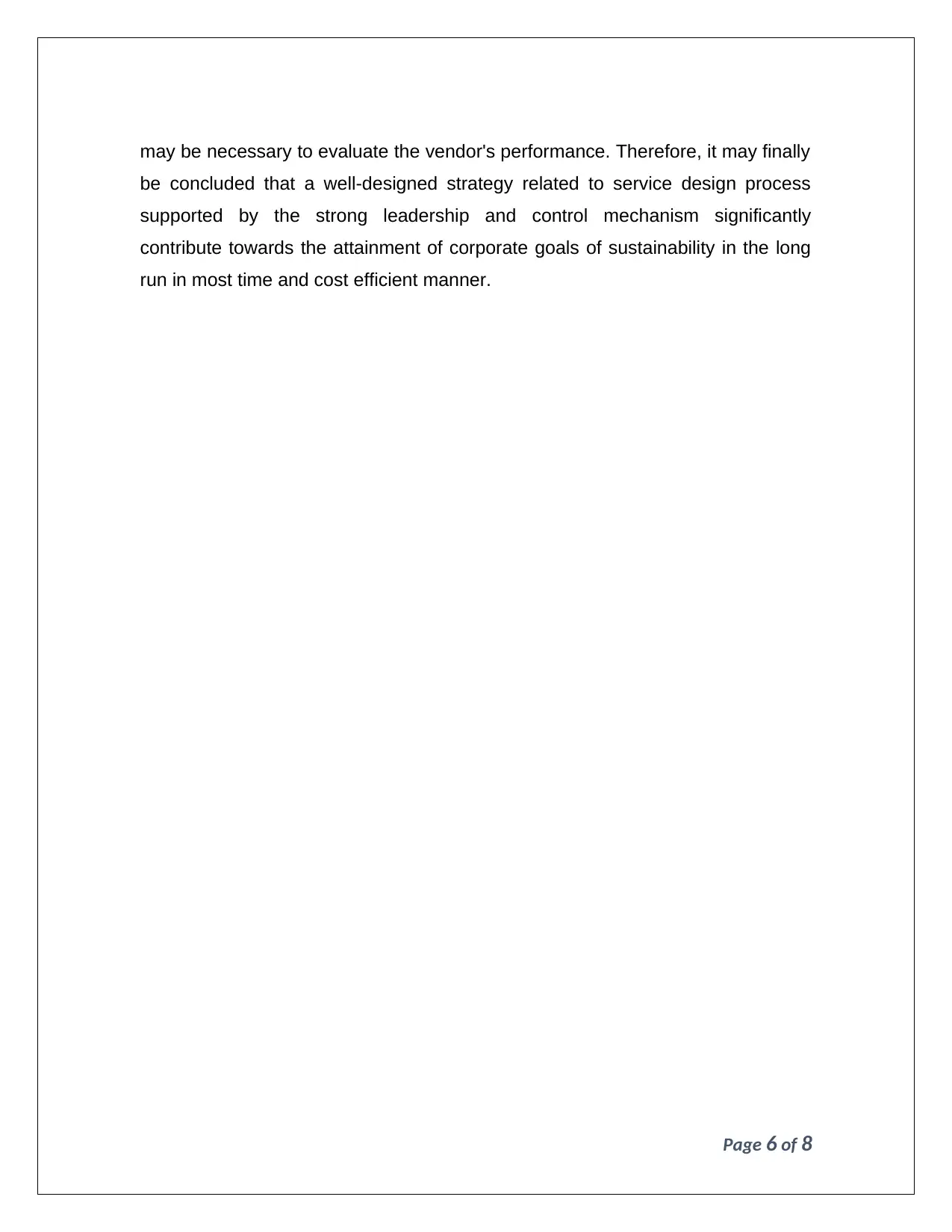
may be necessary to evaluate the vendor's performance. Therefore, it may finally
be concluded that a well-designed strategy related to service design process
supported by the strong leadership and control mechanism significantly
contribute towards the attainment of corporate goals of sustainability in the long
run in most time and cost efficient manner.
Page 6 of 8
be concluded that a well-designed strategy related to service design process
supported by the strong leadership and control mechanism significantly
contribute towards the attainment of corporate goals of sustainability in the long
run in most time and cost efficient manner.
Page 6 of 8
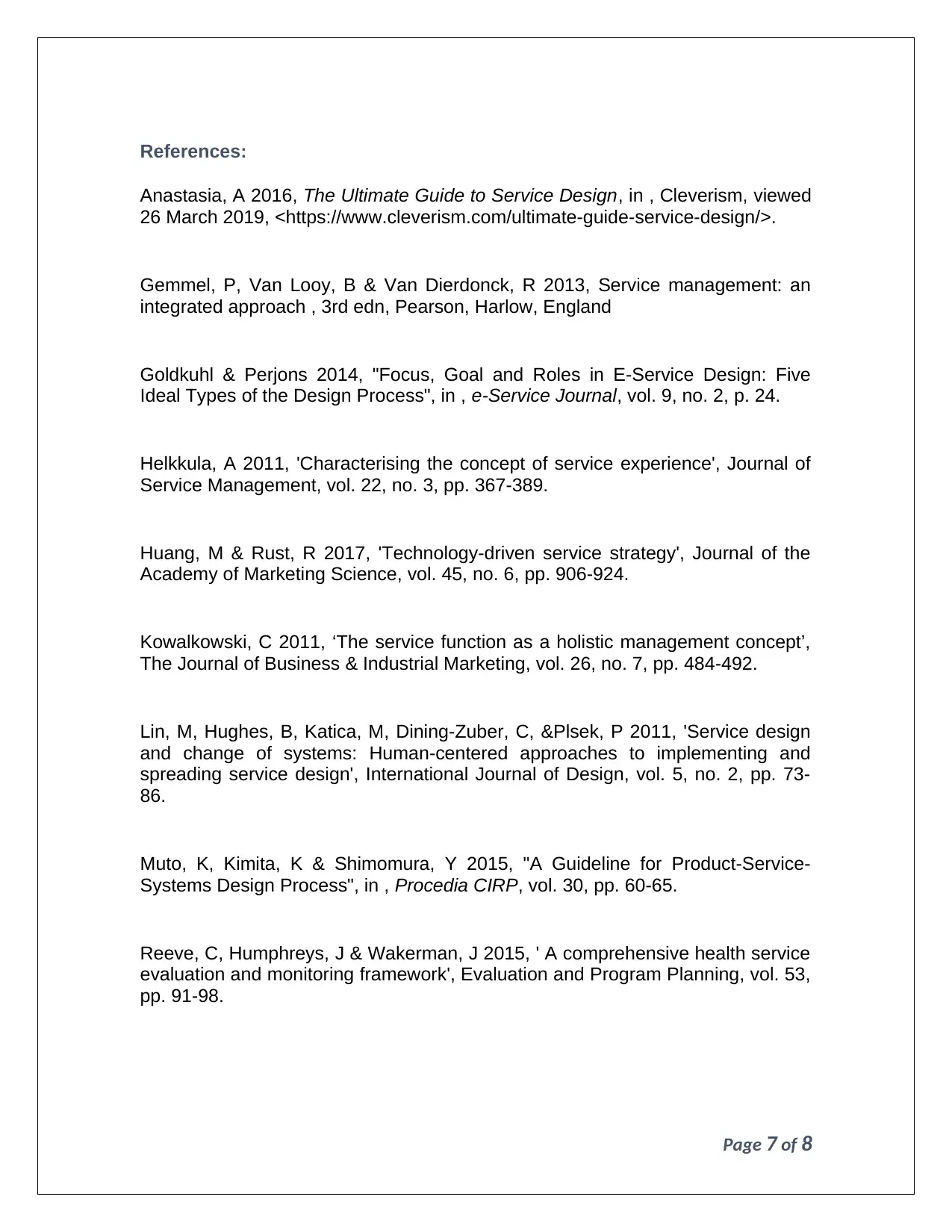
References:
Anastasia, A 2016, The Ultimate Guide to Service Design, in , Cleverism, viewed
26 March 2019, <https://www.cleverism.com/ultimate-guide-service-design/>.
Gemmel, P, Van Looy, B & Van Dierdonck, R 2013, Service management: an
integrated approach , 3rd edn, Pearson, Harlow, England
Goldkuhl & Perjons 2014, "Focus, Goal and Roles in E-Service Design: Five
Ideal Types of the Design Process", in , e-Service Journal, vol. 9, no. 2, p. 24.
Helkkula, A 2011, 'Characterising the concept of service experience', Journal of
Service Management, vol. 22, no. 3, pp. 367-389.
Huang, M & Rust, R 2017, 'Technology-driven service strategy', Journal of the
Academy of Marketing Science, vol. 45, no. 6, pp. 906-924.
Kowalkowski, C 2011, ‘The service function as a holistic management concept’,
The Journal of Business & Industrial Marketing, vol. 26, no. 7, pp. 484-492.
Lin, M, Hughes, B, Katica, M, Dining-Zuber, C, &Plsek, P 2011, 'Service design
and change of systems: Human-centered approaches to implementing and
spreading service design', International Journal of Design, vol. 5, no. 2, pp. 73-
86.
Muto, K, Kimita, K & Shimomura, Y 2015, "A Guideline for Product-Service-
Systems Design Process", in , Procedia CIRP, vol. 30, pp. 60-65.
Reeve, C, Humphreys, J & Wakerman, J 2015, ' A comprehensive health service
evaluation and monitoring framework', Evaluation and Program Planning, vol. 53,
pp. 91-98.
Page 7 of 8
Anastasia, A 2016, The Ultimate Guide to Service Design, in , Cleverism, viewed
26 March 2019, <https://www.cleverism.com/ultimate-guide-service-design/>.
Gemmel, P, Van Looy, B & Van Dierdonck, R 2013, Service management: an
integrated approach , 3rd edn, Pearson, Harlow, England
Goldkuhl & Perjons 2014, "Focus, Goal and Roles in E-Service Design: Five
Ideal Types of the Design Process", in , e-Service Journal, vol. 9, no. 2, p. 24.
Helkkula, A 2011, 'Characterising the concept of service experience', Journal of
Service Management, vol. 22, no. 3, pp. 367-389.
Huang, M & Rust, R 2017, 'Technology-driven service strategy', Journal of the
Academy of Marketing Science, vol. 45, no. 6, pp. 906-924.
Kowalkowski, C 2011, ‘The service function as a holistic management concept’,
The Journal of Business & Industrial Marketing, vol. 26, no. 7, pp. 484-492.
Lin, M, Hughes, B, Katica, M, Dining-Zuber, C, &Plsek, P 2011, 'Service design
and change of systems: Human-centered approaches to implementing and
spreading service design', International Journal of Design, vol. 5, no. 2, pp. 73-
86.
Muto, K, Kimita, K & Shimomura, Y 2015, "A Guideline for Product-Service-
Systems Design Process", in , Procedia CIRP, vol. 30, pp. 60-65.
Reeve, C, Humphreys, J & Wakerman, J 2015, ' A comprehensive health service
evaluation and monitoring framework', Evaluation and Program Planning, vol. 53,
pp. 91-98.
Page 7 of 8
Paraphrase This Document
Need a fresh take? Get an instant paraphrase of this document with our AI Paraphraser
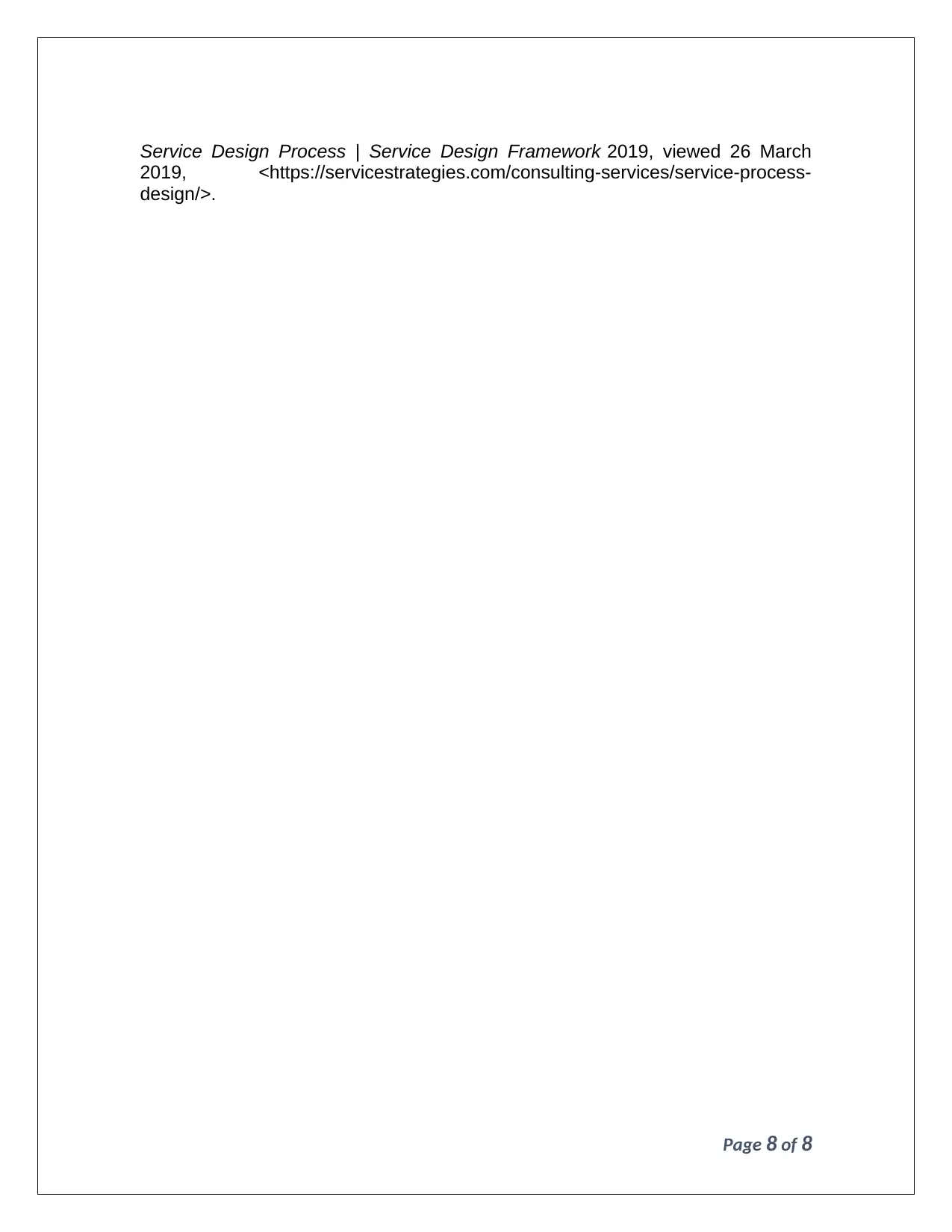
Service Design Process | Service Design Framework 2019, viewed 26 March
2019, <https://servicestrategies.com/consulting-services/service-process-
design/>.
Page 8 of 8
2019, <https://servicestrategies.com/consulting-services/service-process-
design/>.
Page 8 of 8
1 out of 8
Related Documents
Your All-in-One AI-Powered Toolkit for Academic Success.
+13062052269
info@desklib.com
Available 24*7 on WhatsApp / Email
![[object Object]](/_next/static/media/star-bottom.7253800d.svg)
Unlock your academic potential
© 2024 | Zucol Services PVT LTD | All rights reserved.





